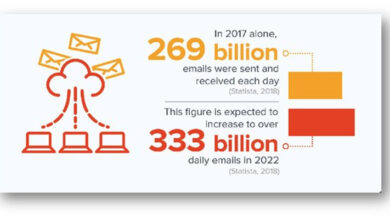The Answer to Stopping Spam Is in Your Wallet
The answer to stopping spam is in your wallet. It’s not about more sophisticated filters or complex technical solutions, but rather about understanding the financial incentives driving spammers. This post delves into the economic forces behind the deluge of unwanted emails, exploring how financial strategies can be used to deter spam, and ultimately, how to make the digital space a safer place for everyone.
This exploration examines the financial implications of spam, from the costs it imposes on businesses to the revenue streams it fuels for spammers. We’ll uncover how businesses and individuals can use financial tools to combat this pervasive problem. We’ll also investigate the technical and social aspects of spam, highlighting the interplay between technology and finance, and the social impact of spam on different cultures.
Understanding the Phrase’s Meaning
The phrase “the answer to stopping spam is in your wallet” is a provocative statement that suggests a financial aspect to combating unwanted digital messages. It implies a connection between the cost of services and the effectiveness of anti-spam measures. This seemingly simple statement sparks several interpretations, each revealing a unique perspective on the problem of spam.The core meaning of the phrase lies in the idea that robust anti-spam technology and infrastructure come at a cost.
This cost is often borne by the businesses and services providing these safeguards, and ultimately, that cost is reflected in the prices consumers pay. The phrase, therefore, suggests that investing in better spam filters is often a shared responsibility between service providers and consumers.
Potential Interpretations
The phrase “the answer to stopping spam is in your wallet” can be interpreted in various contexts, each revealing a different aspect of the problem.
- Financial Investment in Anti-Spam Solutions: Many online services, from email providers to social media platforms, employ various anti-spam measures. These measures, often sophisticated algorithms and specialized hardware, require ongoing maintenance and development, thus requiring financial resources. The statement implies that these costs are ultimately passed on to the user through the prices of their services. For example, a robust spam filter in an email service might be more expensive to implement and maintain, potentially impacting the price of the subscription.
- Impact of Consumer Spending on Service Providers: Consumer spending, through the payment of fees and subscriptions, directly supports the financial viability of service providers. The more consumers pay, the more resources service providers have to dedicate to combating spam. This investment, in turn, strengthens the overall anti-spam infrastructure. An analogy can be drawn to the subscription model of streaming services; greater revenue allows for better content moderation and filtering.
- The Relationship Between Price and Security: The phrase highlights the crucial relationship between the price of a service and the level of security it offers. Users often implicitly understand that a free service might have limitations in its ability to filter spam, while a paid service, by definition, often offers more robust security measures. This concept is relevant to many online services, including cloud storage or email accounts.
Implied Connection Between Finances and Spam
The statement connects financial considerations with spam mitigation in several ways. One way is through the concept of resource allocation. Increased investment in anti-spam measures requires financial backing. This financial support allows for the development and maintenance of sophisticated algorithms and technologies. Another way is through the understanding that free services may be more vulnerable to spam due to their limitations in resource allocation.
Core Message
The core message of the phrase “the answer to stopping spam is in your wallet” is that combating spam is not a simple technical problem, but one that requires a collective effort and investment. This investment, often reflected in the prices of online services, ultimately strengthens the defenses against unwanted digital messages.
Resonance with Different Audiences
This message resonates differently with various audiences. Consumers may see this as an acknowledgment of the cost associated with a secure online experience. Service providers might understand this as a call for responsible resource allocation and the importance of user support for their operations. Government regulators might interpret this as a necessity to promote a balance between consumer access and online safety.
Examining the Financial Implications

Spam, while often perceived as a nuisance, carries significant economic weight. Understanding the financial underpinnings is crucial to developing effective countermeasures. This section delves into the economic aspects of spam, exploring its costs, revenue streams, and the incentives driving spammers. Furthermore, it will discuss how businesses utilize financial tools to combat this pervasive issue and compare the effectiveness of different strategies.Financial incentives heavily influence spammers’ actions.
The perceived profitability of spamming, though often based on a minuscule return per message, is a key driver. The low cost of sending vast numbers of emails, combined with the potential for significant returns from a small percentage of successful recipients, creates a tempting proposition. Spammers often leverage automated systems, significantly reducing the per-message cost.
Spam’s Economic Costs
Spam’s economic impact extends far beyond the direct costs incurred by individuals and businesses. The costs are multifaceted, encompassing direct expenses like IT resources for filtering and blocking spam, and the indirect costs of lost productivity and damaged brand reputation. The cumulative impact of these costs on organizations and consumers is substantial.
Spam Revenue Streams
Spam’s revenue is generated through various avenues, including phishing scams, malicious software distribution, and the promotion of fraudulent goods or services. Often, the goal isn’t immediate profit from each individual email, but rather the cumulative effect over time. Spammers might also monetize their infrastructure, renting it out for other malicious activities.
The answer to stopping spam is often surprisingly simple: put your money where your mouth is. Think about how much you’re spending on spam filters and wasted time dealing with it. Instead of relying on software solutions, consider the groundbreaking work of the NASA team that’s powering a plane with a remote laser; NASA’s team powers plane with remote laser.
It’s a similar principle, focusing resources on a solution that prevents the problem, rather than just treating the symptoms. Ultimately, investing in a more secure and reliable communication infrastructure is the true answer to stopping spam in your wallet.
Financial Tools for Combating Spam
Businesses employ a range of financial tools to deter spam. These tools can be categorized broadly as preventive and reactive. Preventive measures often involve subscription-based spam filtering services, which are a major part of the expense for some businesses. Reactive measures, such as legal action against spammers, can be costly but often yield substantial results.
Comparison of Financial Strategies
Different financial strategies for combating spam have varying levels of effectiveness and associated costs. Some strategies focus on preventing spam, while others aim to deter spammers. The choice of strategy often depends on the specific resources and priorities of the affected entity.
| Strategy | Description | Effectiveness | Implementation Costs |
|---|---|---|---|
| Spam Filtering Services | Subscription-based services that identify and block spam emails before they reach inboxes. | High, especially for targeted spam. | Variable, depending on volume and features. |
| Domain Reputation Management | Maintaining a positive reputation for your domain to reduce the likelihood of being blacklisted. | Moderate, effective in preventing some types of spam. | Low to moderate, depending on the level of proactive maintenance. |
| Legal Action | Taking legal action against spammers and their operations. | High, particularly in cases with significant evidence. | High, involving legal fees and investigation costs. |
| Financial Penalties | Implementing financial penalties for spammers, potentially discouraging further activities. | Moderate, effectiveness varies depending on the jurisdiction and enforcement mechanisms. | Low to moderate, mainly related to administrative processes. |
| Investment in Security Infrastructure | Strengthening the overall security infrastructure to deter spammers. | Moderate to high, depending on the robustness of the infrastructure. | High, especially if implementing advanced systems and technologies. |
Exploring the Technical Aspects
Spam, a pervasive digital plague, relies on sophisticated technical mechanisms for its proliferation. Understanding these mechanisms is crucial for developing effective countermeasures. This section delves into the technical intricacies of spam, focusing on its spread and the relationship between technical solutions and financial considerations. We will also explore practical technical solutions and their effectiveness, alongside the associated costs.
So, the answer to stopping spam might actually be in your wallet, after all. With analysts reporting a surge in PC sales thanks to the popularity of new notebooks, analysts notebooks warm up pc sales are a sign of more people needing stronger defenses against online threats. This, in turn, means more investment in anti-spam solutions, ultimately meaning spammers will need more and more money to keep up.
It’s a bit of a cold, hard truth, but the answer to spam is often in the dollars you’re willing to spend on security.
Technical Mechanisms of Spam Propagation
Spammers utilize various techniques to disseminate their messages. These methods exploit vulnerabilities in email systems and internet infrastructure. One key method is the use of botnets, networks of compromised computers controlled remotely. These bots can send massive volumes of spam emails, overwhelming recipients’ inboxes and clogging servers. Another common technique involves spoofing, where spammers forge email headers to make their messages appear to originate from legitimate sources.
This deception tricks recipients into believing the messages are authentic. Sophisticated spammers often employ techniques like dynamic IP address rotation and proxy servers to further mask their activities and evade detection. These strategies aim to evade email filters and anti-spam measures.
Technical Solutions and Financial Implications
Various technical solutions are employed to combat spam. These solutions can be broadly categorized into preventative and reactive measures. Preventative measures aim to block spam at its source, while reactive measures focus on identifying and filtering spam messages after they have been sent. The effectiveness and implementation costs of these solutions vary significantly.
| Technical Solution | Description | Effectiveness | Implementation Costs |
|---|---|---|---|
| Spam Filters | Software programs that analyze incoming emails based on various criteria, such as s, sender addresses, and email content, to identify and block spam. | High, but can vary depending on the complexity of the filter and the sophistication of the spam. | Moderate, ranging from free open-source options to expensive commercial solutions. |
| Blacklisting and Whitelisting | Techniques that maintain lists of known spam senders (blacklists) or trusted senders (whitelists) to filter emails accordingly. | Moderate, effectiveness depends on the accuracy and comprehensiveness of the lists. | Low to moderate, depending on the resources required for list maintenance and updates. |
| Content Analysis | Sophisticated algorithms analyze email content for patterns, s, and characteristics associated with spam. | High, especially when combined with other techniques. | High, requiring specialized expertise and computational resources. |
| DNS-based Filtering | Spam filtering based on domain name system (DNS) data, using DNS blacklists to identify spam sources. | High, effective in preventing large-scale spam campaigns. | Moderate, relying on established DNS infrastructure. |
| Email Authentication Protocols (SPF, DKIM, DMARC) | Protocols that verify the sender’s identity and prevent email spoofing. | High, enhances email security and reduces spoofing. | Low to moderate, depending on implementation complexity. |
Technical Terminology in Spam Prevention
Understanding the technical terms related to spam prevention is essential for comprehending the solutions and their applications. Here are some key terms:
- Botnet: A network of compromised computers controlled remotely by a malicious actor, often used for sending spam.
- Spoofing: The act of forging email headers to make messages appear to originate from a different source. This is a crucial technique used by spammers to evade detection.
- Dynamic IP Address Rotation: Spammers employ this technique to change their IP addresses frequently to avoid being blocked. This makes tracing and identifying the source of spam more challenging.
- Proxy Servers: Intermediate servers used by spammers to mask their true IP addresses and locations.
- Spam Filters: Software programs designed to identify and block spam emails based on various criteria.
- Blacklist: A list of known spam senders that filters out emails from these sources.
- Whitelisting: A list of trusted senders, allowing emails from these sources to bypass filtering.
- DNS Blacklists: Lists of IP addresses or domains associated with spam, used by DNS servers to block spam.
- SPF (Sender Policy Framework): A protocol that defines the authorized mail servers for a domain, helping to prevent spoofing.
- DKIM (DomainKeys Identified Mail): A protocol that uses digital signatures to verify the sender’s identity and email content integrity.
- DMARC (Domain-based Message Authentication, Reporting & Conformance): A protocol that combines SPF and DKIM, providing a comprehensive approach to email authentication.
Analyzing the Social Implications
Spam’s relentless barrage isn’t just a technical problem; it deeply impacts our social lives. The constant influx of unwanted messages, be it email, text, or social media, creates a pervasive sense of annoyance and disruption. This, in turn, influences how we perceive and interact with financial systems, potentially affecting trust and overall well-being.The social impact of spam is multifaceted.
Beyond the immediate inconvenience, it fosters a sense of distrust and frustration. The constant bombardment can lead to individuals feeling overwhelmed and marginalized. This sense of intrusion affects their emotional state and impacts their perception of the digital world and financial services. It’s not just about the spam itself; it’s about the broader perception of security and reliability that it erodes.
Social Impact of Spam Frustration
The relentless barrage of unsolicited messages, regardless of the platform, creates significant frustration and a negative user experience. This leads to wasted time and resources as individuals must sort through and delete unwanted content. The annoyance stemming from spam is a significant social concern, affecting productivity and overall well-being. Individuals often resort to filtering and blocking mechanisms, which can themselves be frustrating if they are ineffective or require significant effort to manage.
Social Perceptions and Financial Decisions, The answer to stopping spam is in your wallet
Negative social experiences with spam directly influence perceptions of financial services. Individuals who have had numerous frustrating encounters with spam are more likely to be wary of online transactions, and even traditional financial institutions. This mistrust can lead to a reluctance to use online banking, invest in financial products, or participate in other digital financial services. This distrust is particularly acute for vulnerable populations, those less technologically adept, or those with limited financial literacy.
Potential Social Issues Associated with the Phrase “Spam is in your wallet”
The phrase “Spam is in your wallet” directly connects the nuisance of spam to financial loss. It suggests a direct correlation between the annoyance and the potential for financial harm. This can create a strong negative association between online interactions and financial safety, leading to a reluctance to engage with online services. The phrase highlights the concern that unwanted messages can be a precursor to fraudulent activity, potentially impacting the overall perception of online security.
Social Factors Influencing Spam Prevention
This table Artikels key social factors impacting spam prevention efforts:
| Social Factor | Description | Impact on Spam |
|---|---|---|
| Cultural Differences in Tolerance | Different cultures have varying levels of tolerance for unsolicited messages. Some cultures may be more accepting of spam, while others may find it highly disruptive. | Different cultural norms may lead to varied responses to spam prevention strategies. |
| Trust in Technology | Individual’s confidence in the security and reliability of technology plays a crucial role in how they perceive spam and respond to prevention methods. | A lack of trust in technology can hinder the adoption of online banking or other financial services. |
| Financial Literacy | Individuals with higher financial literacy are generally more likely to recognize and avoid spam related to financial services. | Education can play a key role in empowering individuals to recognize and avoid spam attempts. |
| Social Pressure and Awareness | Social networks and awareness campaigns play a critical role in educating individuals about spam and its potential dangers. | Awareness campaigns can encourage the use of safer practices and reporting of suspicious activity. |
| Privacy Concerns | Concerns about data privacy and the potential misuse of personal information can influence individuals’ responses to spam. | Individuals may be more wary of opening emails or clicking on links from unknown sources. |
Comparing Social Responses to Spam Across Cultures
Social responses to spam vary significantly across cultures. In cultures with a strong tradition of interpersonal communication, the intrusion of spam can be seen as more disruptive and unwelcome. In contrast, cultures with a more open and accepting approach to mass communication may exhibit a different tolerance threshold for unsolicited messages. Furthermore, the impact of spam may be magnified in societies where financial transactions are heavily reliant on digital platforms.
These varying cultural contexts influence the effectiveness of different spam prevention strategies.
Illustrating Real-World Examples
Financial incentives have proven to be a powerful tool in the fight against spam. By directly impacting the profitability of spammers, these incentives can significantly reduce the volume and frequency of unwanted messages. Understanding how these incentives are implemented and their effectiveness in real-world scenarios is crucial for developing effective anti-spam strategies.Real-world examples of financial disincentives and incentives against spam often involve a combination of technical and legal approaches.
These are not standalone solutions but rather parts of a larger system designed to make spam less profitable and more difficult to execute.
Okay, so the answer to stopping spam might just be in your wallet. It’s all about paying for services that filter out the junk mail. This is especially relevant now that Napster beta is ready to rock n roll here , and the rise of file-sharing services could potentially increase the spam problem. In the end, the best way to keep your inbox clean might just involve a little financial investment.
Financial Disincentives for Spam
Financial disincentives against spam often focus on making it too expensive to operate. This can be achieved through various mechanisms. For instance, filtering services that flag and block spam emails often employ a system of escalating penalties for repeat offenders. These penalties can take the form of temporary or permanent account suspension, higher transaction fees, or even legal action.
Financial Incentives for Reporting Spam
Conversely, financial incentives encourage users to report spam. These systems often reward individuals or organizations for reporting spam, thereby incentivizing the proactive identification and reporting of malicious or unwanted content. Rewards can be in the form of points, credits, or other forms of recognition, potentially leading to greater engagement in fighting spam.
Reward System for Spam Reporting
Imagine a system where users are rewarded for reporting spam emails. This reward system could be integrated into email clients or anti-spam software. The system might display a simple graphical user interface (GUI) showing the points awarded for each reported message.  This image depicts a simplified reward system. The user interface (UI) displays a progress bar representing the user’s accumulated points for reporting spam. The points can be exchanged for various rewards, such as discounts on services, premium features, or even charitable donations. The visual representation of the reward system clearly demonstrates the incentive structure, making it easily understandable and motivating users to participate in spam reporting. The graphic design and visual cues are meant to emphasize the positive reinforcement aspect of the system.
This image depicts a simplified reward system. The user interface (UI) displays a progress bar representing the user’s accumulated points for reporting spam. The points can be exchanged for various rewards, such as discounts on services, premium features, or even charitable donations. The visual representation of the reward system clearly demonstrates the incentive structure, making it easily understandable and motivating users to participate in spam reporting. The graphic design and visual cues are meant to emphasize the positive reinforcement aspect of the system.
Potential Solutions and Strategies

Tackling spam requires a multifaceted approach, recognizing that a purely financial strategy, while impactful, isn’t a silver bullet. This section delves into potential financial solutions, outlining a comprehensive plan for implementation, and acknowledging the limitations and challenges inherent in such an approach. We’ll explore how a financial strategy can be interwoven with technical and social interventions for maximum effectiveness.Financial strategies against spam need to consider the economic incentives driving spammers.
By making the cost of spam higher than the potential gain, we can disincentivize the practice. This approach isn’t about stopping all spam, but rather significantly reducing its volume and impact.
Financial Disincentives for Spam
Spammers are motivated by profit. Their goal is to maximize returns with minimal investment. A financial strategy must target this profit motive.
- Increased Transaction Costs: One potential solution is to significantly increase the cost of sending spam through financial mechanisms. This could involve a tiered system where higher volumes of spam incur exponentially higher transaction fees. For example, a sender sending 1000 emails might pay a negligible fee, while a sender sending 100,000 emails could face a fee that makes the endeavor unprofitable.
This approach is highly effective against mass-scale spam campaigns.
- Financial Penalties for Spammers: Identifying and penalizing spammers financially is a crucial step. This could involve a system where individuals or organizations sending spam are subject to significant financial penalties, including fines or blocked access to payment systems. Such penalties need to be substantial enough to deter future activity and ensure the financial burden outweighs any potential gains.
- Rewards for Spam Reporting and Blocking: Creating a financial incentive for individuals and organizations to report spam can be a valuable addition to a financial strategy. This could involve rewarding individuals or organizations who effectively identify and block spam emails, creating a market for identifying spam. This could range from small financial incentives to substantial rewards for significant contributions to spam filtering efforts.
Comprehensive Implementation Plan
This plan Artikels specific actions, expected outcomes, and potential challenges associated with a financial strategy against spam.
Action 1: Implement a tiered system for transaction fees, escalating with the volume of spam emails.
Expected Outcome: Reduced spam volume from large-scale campaigns.
Potential Challenges: Implementation complexity, potential for abuse, and compliance concerns.
Action 2: Develop a robust system for identifying and penalizing spammers based on verifiable evidence.
Expected Outcome: Deterrence of spam activity, increased accountability for spammers.
Potential Challenges: Defining “spam” precisely, legal and regulatory considerations, and ensuring fairness and transparency.
Action 3: Establish a financial reward system for reporting and blocking spam.
Expected Outcome: Increased participation in spam mitigation efforts, improved accuracy of spam filtering.
Potential Challenges: Ensuring the integrity of the reporting process, establishing appropriate reward structures, and managing the potential for fraud.
Limitations and Challenges
Implementing a purely financial strategy against spam faces several significant limitations.
- Complexity of Enforcement: Identifying and enforcing penalties against spammers can be complex and resource-intensive. It requires a robust infrastructure for monitoring, investigation, and legal action. The sheer volume of spam makes complete eradication difficult.
- Circumvention Strategies: Spammers are resourceful and will likely adapt to new financial disincentives. They might use proxies, anonymization techniques, or alternative communication channels to circumvent these measures. Constant vigilance and adaptation are necessary.
- Ethical Concerns: Balancing the need to deter spam with ensuring fairness and avoiding unintended consequences for legitimate users is critical. Financial penalties should not disproportionately affect legitimate users.
Ultimate Conclusion: The Answer To Stopping Spam Is In Your Wallet
In conclusion, the answer to stopping spam lies not just in technology, but in a multifaceted approach that incorporates financial incentives. By understanding the financial motivations behind spam and implementing effective financial deterrents, we can significantly reduce the problem. The strategies Artikeld here offer a practical roadmap for businesses and individuals to take control of their digital experience and fight back against the deluge of unwanted messages.







